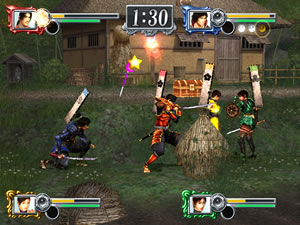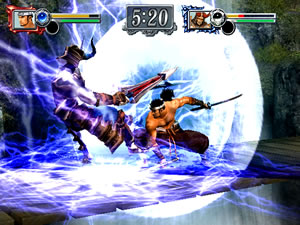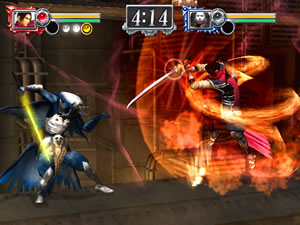Super Samurai or Ragged Ronin?
Capcom has made a habit out of turning franchise characters into prize fighters.
Just look at Strider Hiryu, who started off as a Capcom ninja back in the late
80’s
only to be turned into a fighting machine for the Marvel
vs. Capcom series. Then there’s everybody’s favorite blue wonder, Mega Man,
who also joined the fight club after blasting through side-scrolling adventures
for years.
Never one to stray too far from tradition, Capcom has trained the cast of the Onimusha series for battle in a new arena. The resulting Onimusha
Blade Warriors is an interesting cross-breed of the traditional action and fighting genres, starring characters from both Onimusha games alongside a few special guests.
On one side of the blade we have the sword-swinging, soul-sucking action that Onimusha fans
are already familiar with, and on the other we have what can best be described
as a side-scrolling fighter. It all feels like a weird, Capcom version of Super
Smash Melee. Unfortunately, this kind of thing works much better as an extra
to a more robust game than a stand-alone title, evidenced by its repetitive gameplay
and lack of replay value.
You’ll begin with a nice selection of good and bad guys, though the obvious headliners
are Samanosuke Akechi and Jubei Yagyu, the stars of the Onimusha games.
Other notables in the cast of Blade
Warriors include the ninja Kotaro Fuma, the demon lady Jujudormah, and
the zombie warrior named, oddly enough, Zombie Warrior, as well as unlockables
like Gogandantess. Blade Warriors provides a good
field of fighters, but since they all operate the same way, the difference is
only skin deep.
A paltry three modes are available, including the single-player Story mode, a Versus mode and a Custom Versus modes. In Story mode, you’ll progress through a series of fights, picking up weapons and using absorbed souls to strengthen your offensive, defensive and magic powers. It’s important to note that the “Story” part of Story mode is false advertising. The few cutscenes are simply there to break up the action and don’t tell much of a story at all.
Your objectives in this “Story” mode vary depending on the level. Some have you collecting a specific amount of “victory souls” in a certain amount of time, while others just require you to slice through everything in sight. The battles take place in Onimusha‘s familiar territories and consist of several tiers. For example, let’s say that a battle takes place in front of a building. The ground level would be tier one, the building’s balcony would be tier two and the roof would be tier three. All you need to do to move from tier to tier is a double tap in the appropriate direction. While the game is presented in 3D, this tier fighting shows that it actually fights on a plane that is more or less 2D.
 The controls are simple enough and the experienced Onimusha player will have no problems at all jumping right in, as the basics closely resemble the original controls of Onimusha with buttons for Attack, Block, Ready and Absorb Souls. The only new bits are a jump button and that double tap to move up and down tiers. You’ll still have plenty of combos to execute, especially when you use the Ready Stance modifier, and the critical one-hit kills are still on hand for the experienced fighter.
The controls are simple enough and the experienced Onimusha player will have no problems at all jumping right in, as the basics closely resemble the original controls of Onimusha with buttons for Attack, Block, Ready and Absorb Souls. The only new bits are a jump button and that double tap to move up and down tiers. You’ll still have plenty of combos to execute, especially when you use the Ready Stance modifier, and the critical one-hit kills are still on hand for the experienced fighter.
In many ways, Blade Warriors is just a dumbed down Onimusha.
In an effort to make it a little more interesting, at least a few new items have
been included. More souls have been introduced that provide boosts to power and
speed. Other souls decrease your health and some can render you temporarily invincible.
You’ll also find some wacky weapons along the way, though red squeaky mallets
and folding fans look a little ridiculous next to more serious weapons like new
blades and machine guns.
I suspect that at its core, Onimusha Blade Warriors was designed for multi-player fighting. Versus is a simple multiplayer mode that allows up to four warriors simultaneously battle it out with an option to include extra weapons and Custom Versus allows players to use the characters that have been developed in Story mode. Both fare better than Story mode if only because you don’t have to sit through the stupid cutscenes.
 It’s really surprising that the visuals in Blade Warriors are less impressive than its forefathers. While the character models appear the same for the most part, the arenas are a lot less polished than the locales that we’re used to seeing in the Onimusha series. It’s the definition of uninspired.
It’s really surprising that the visuals in Blade Warriors are less impressive than its forefathers. While the character models appear the same for the most part, the arenas are a lot less polished than the locales that we’re used to seeing in the Onimusha series. It’s the definition of uninspired.
The audio is a little better with appropriate music tracks and sound effects,
but I still can’t get over the use of English dubbing in the cutscenes. After the subtitled original, English dialogue feels like a campy dub.
Aside from the multiplayer game, there isn’t much replay value here. Despite
the different objectives between levels, it’s really all about cutting down everything
that moves. The thought of building up your character’s power is great in the
beginning, but you’ll
quickly tire of the same old combat.
While a promising concept, Onimusha Blade Warriors turns out
to be a simple, overpriced appetizer for Onimusha
3: Demon Siege due out at
the end of the month. Repetitive combat only provides gamers with a taste of
the original Onimusha flavor and the absence of any real story or unique features
leave this samurai wandering the battlefield without much fight left in him.
-
Pick up and play
-
Free-fighting Onimusha
-
That gets old fast
-
This blade doesní¢â‚¬â„¢t look so sharp
-
Little replay value







